BLUEPRINT Solutions
BLUEPRINT Is A Mature TechnologyBLUEPRINT's Concurrent Object Runtime Environment (CORE) has been in continuous commercial use since 1993. In the early days most applications were associated with acoustics (especially sonar) but over the last 12 years it has been used for a wide variety of projects. 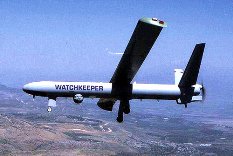
Watchkeeper
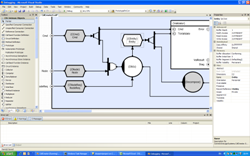
Blueprint Toolset
Early adopter and in-house applicationsBLUEPRINT technology has been tested in the most demanding production environment by our early adopters who typically produce complex, real-time and distributed applications. Past project have ranged from BLUEPRINT’s own development toolset, voice over IP, image compression, and software radio; all the way up to enterprise scale projects in more diverse fields that include acoustics, seismology, simulation and surveillance. In recent times it has been used for a number of mission critical systems including the Royal Navy’s Surface Ship Torpedo Defense system (SSTD), the Watchkeeper Unmanned Aerial Vehicle (UAV), and commercial and military Synthetic Aperture Sonar (SAS). In addition to commercial projects we have also produced several technology demonstrator applications, some of which are listed here. Our customers and their clients include; Thales, QinetiQ, BAE Systems, Go-Science, Ultra Electronics, Cubic, Applied Signals Technology Inc, Serco, APL, the UK and Norwegian Navies and NATO. Deepscan Sidescan SonarAchievements- First commercial project using the first generation of BLUEPRINT's CORE runtime
- Successfully ported from C40 DSPs to Pentium PCs
DescriptionThe very first Connective Logic project was a sidescan sonar developed by Ultra Electronics in 1993. This project used a prototype version of BLUEPRINT's CORE runtime and having established the feasibility of the technology, the existing version was developed. The sonar consisted of three components; a C40 DSP based tow-fish, a C40 based surface unit, and a Motorola 68k based console. The system collected sidescan and sub-bottom profiler data, and performed and displayed beam-forming and bathymetric processing. The following link provides more information on the Deepscan system:
http://www.oicinc.com/interferometric_ueos-deepscan.html
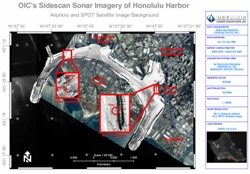
(Click to enlarge...)
In 1999, the C40 based system was ported to the current version of the CORE runtime and is now hosted on various multi-core Pentium platforms running the windows operating system. The system has a very high concurrency and is expected to scale for decades to come without modification (as Intel increase the number of cores). The UK's Surface Ship Torpedo Defence SystemAchievements- Non-programmer, sonar specialist created circuitry from which 40% of total delivered code was generated
- Same application code shown to run on a PowerPC running VxWorks and a PC running Windows
- 27 month contract - delivered 6 months early
- Excellent reliability record
- MoD waived 50% CPU utilization rule
DescriptionThe UK’s surface ship torpedo defense system was designed by a sonar specialist with little or no conventional programming experience. He was able to create the entire top level infrastructure for the system by drawing the circuitry. The result was that 40% of the deliverable code was generated from circuit diagrams, and although the original target was a PowerPC based asymmetric multi-processor running VxWorks, almost all development and debugging was carried out on standard Windows laptops. The final delivery was actually hosted on rack mounted Pentiums. A common problem with applications of this type is that the incremental addition of extra functionality over the project lifetime often means that extra CPUs are needed, and this frequently involves expensive re-organization of code (to re-establish good load balance). In order to mitigate this, the UK MoD usually requires that delivered systems must not use more than 50% of their available CPU. Because CORE applications are dynamically scalable (CPUs can be recruited and/or retired at any stage and the system automatically re-balances), this requirement was waived for SSTD and replaced by the less onerous requirement that there should be sufficient space in the racks to allow for future expansion. This considerably cut the deliverable hardware costs. The system has been in service for several years now (24/7) and has never experienced a deadlock or race of any kind. The SSTD consoles were recently ported from Windows to Red Hat Linux without modification to circuitry. The 27 month development program was completed 6 months ahead of schedule. 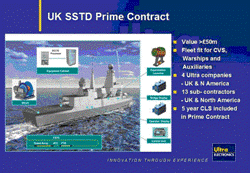
(Click to enlarge...)
Because it is portable and extendible and can be maintained on available desk-top hardware, SSTD has an extremely low cost of ownership and will shortly go into service with the Turkish Navy. It is also currently being trialed by two other Navies. As well as providing our technology, we sub-contracted the HCI development, and provided most of the remaining engineering under Ultra management. PROSAS Synthetic Aperture SonarAchievements- First automated, full-swath, real-time Synthetic Aperture Sonar (SAS) developed by any company
- Delivered on a range of different platforms and topologies
DescriptionApplied Signals Technology’s PROSAS was the first automated, full swath, real-time Synthetic Aperture Sonar (SAS) developed by any company. The number of cards required to execute PROSAS depends upon the characteristics of the sonar that it runs with. So sonar with large numbers of hydrophones and high data bandwidth, require more CPUs in the PROSAS deliverable system. The application is portable, and most development occurs on standard laptops and desktops using replayed data (gathered at sea). The deliverable platform is typically made up of dual AMD Opteron processors on a gigabit Ethernet network. If the hosted sonar type changes, cards can be added or removed until the overall load achieves an acceptable level (typically around 85% sustained load), and that then becomes the deliverable configuration. Because CORE's holographic scheduling allows processors to be added or removed at runtime, determining the number of CPU’s required for optimal execution with a new target sonar is an extremely quick and simple operation. For more details of the PROSAS system visit;
http://www.appsig.com/products/prosas.htm
We also provided on-site engineering services for this project. MINESCOUT Mine Hunting SystemAchievementsDescriptionThe MINESCOUT mine hunting workstation developed by Applied Signals Technologies analyzes sensor data from Autonomous Undersea Vehicles (AUVs) and provides mine classification reports to the mission executive. For more details of the MINESCOUT system visit;
http://www.appsig.com/products/minescout.htm
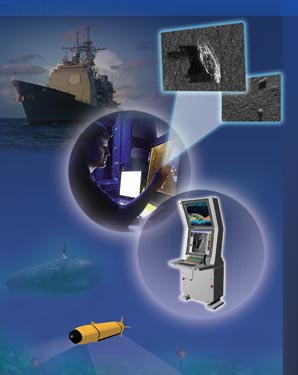
MINESCOUT
We also provided on-site engineering services for this project. The Generic Sound Room Simulator (GSR)Achievements- First commercial project using the current generation of BLUEPRINT's CORE runtime
- Legacy application - ported to use CORE runtime
- Same application code shown to run on three different architectures
DescriptionGSR is an advanced distributed interactive simulation project developed by Thomson Marconi Sonar Ltd. It runs on twelve networked PCs under Sun Solaris x86. This simulation provided a fully operational training suite featuring a range of current in-service equipment for the Royal Navy. Developed in 1995, this was the first project to use the current version of the BLUEPRINT's CORE runtime. It was originally ported to CORE from an i860 based CSPI asymmetric processing card. Once ported to CORE, the application ran on an i860 based Mercury asymmetric multi-processor which was the intended delivery platform. However, because most CORE projects are fully portable, development took place on various PC and SPARC platforms. It became apparent prior to delivery that the most cost effective solution was to deliver on a network of dual Pentium PCs, and this was therefore the final target. The GSR application was the first to demonstrate identical code executing on three different architectures; asymmetric shared memory, symmetric shared memory, and distributed shared memory. RSIM Radar StimulatorAchievements- Legacy application - ported to use CORE runtime
DescriptionThe UK Tactical Air Command and Control System required a simulator to enable development and testing of their system. The RSIM application generates a simulated airspace environment with multiple radar targets and properties. This simulated environment can be viewed by six independent radars at various locations. 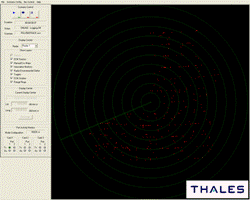
(Click to enlarge...)
This application was ported to BLUEPRINT's CORE runtime from existing code and as with all CORE-based projects, the executable will scale to the number of available CPUs (cores) without any need to modify code or re-build. The development of RSIM was sub-contracted to Connective Logic. Watchkeeper Unmanned Aerial Vehicle; High Integrity Data LinkAchievementsDescriptionThe Watchkeeper Unmanned Aerial Vehicle's radio communications use a Time Division Multiple Access (TDMA) scheme so that bandwidth can be shared between multiple terminals. As well as providing the real-time infrastructure for the deliverable system, The CORE runtime was also used to implement a device simulation package that enabled the software to be developed and debugged on standard PCs prior to deployment on the target platform (proprietary PowerPC based cards running the Integrity operating system). For more details of the Watchkeeper program visit;
http://www.cubic.com/cda1/Prod_&_Serv/
C4ISR_Prod_&_Sys/Data_Links/hidl.html

(Click to enlarge...)
As well as our technology, we also provided on-site engineering services for the project. NetCom Voice over IP SystemAchievementsDescriptionThe NetCom project is a multi-channel distributed Voice Broadcast over IP application and is also an in-house project. Users can talk and listen on a selection of channels. Each channel is broadcast to all users within a ‘NetCom network’. Channels within a ‘NetCom network’ can be linked to other ‘NetCom networks’. The dialog (build configurable) can be used to control all aspects of talking and listening selections. 
(Click to enlarge...)
The BLUEPRINT ToolsetAchievements- Demonstrated applicability of CORE to applications with highly irregular concurrency
- Demonstrated interoperability with the Standard Template Library (STL)
- Demonstrated interoperability with Intel's Concurrent Container library
DescriptionThe BLUEPRINT toolset consists of a visual schematic capture tool that is integrated with Microsoft Visual Studio 2005/2008 and a circuit translator for converting circuits into their sequential language equivalents. 
(Click to enlarge...)
The BLUEPRINT toolset is an in-house project and has been developed as a BLUEPRINT/C++ application with a C# GUI. The BLUEPRINT part co-ordinates the concurrent interactions between the user interface, database and attached services such as validation, browsing, debugging and translation, ensuring best use of available processing cores. The C# GUI was developed using Microsoft's Domain Specific Language (DSL) tools framework and the two technologies interoperate seamlessly. BLUEPRINT's translation service allows multiple clients to interleave simultaneous translations both on a local machine and across a network. The translation processing is distributed across all participating nodes within the network thus allowing a single user to take advantage of the latent processing power exposed by the rest of the group. The nature of this processing is highly irregular because any node in the processing chain can produce any number of outputs. The translator also makes extensive use of the Standard Template Library (STL) and Intel's Concurrent Containers. Top level circuitry for the translator is shown below. 
(Click to enlarge...)
Finite Difference Time Domain EngineAchievementsDescriptionThis is another in-house project and in this case provides a generic FDTD solving capability. This project uses circuit inheritance to create abstract circuitry that can then be resolved for the particular problem being solved. Thus, all communications and infrastructure can be re-used to solve any FDTD problem. 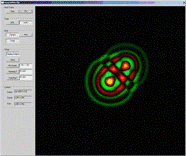
(Click to enlarge...)
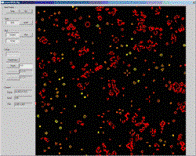
(Click to enlarge...)
The figures above show screenshots of two different resolutions; the first is the ‘game of life’ and the second is a simple wave propagation model. Realtime Image Compression SystemAchievementsDescriptionThe video compression project is primarily an image processing application designed to provide real time compression of an input video stream. The maximum resolution of the video stream that can be compressed whilst still maintaining real time is proportional to the available processing resource. The processing resource can be dynamically added or removed at any time during processing. The video stream data is subject to noise filtering and a 2D FFT. Reference frames are taken at regular intervals and by using the reference frames a change intermediate frame is produced. These resulting reference and intermediate frames are written to file. Decompression involves the reconstruction of the reference and intermediate data frames into an output video stream. 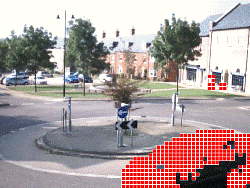
(Click to enlarge...)

(Click to enlarge...)

(Click to enlarge...)
| 





